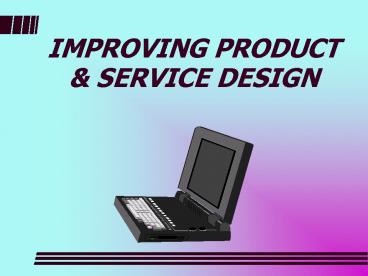IMPROVING PRODUCT - PowerPoint PPT Presentation
1 / 20
Title: IMPROVING PRODUCT
1
IMPROVING PRODUCT SERVICE DESIGN
2
INVOLVE THE CUSTOMER
- Involve the customer
- Educate the customer
- Incorporate quality function deployment (QFD)
- Consider the Kano model
3
QUALITY FUNCTION DEPLOYMENT
- Quality Function Deployment
- Voice of the customer
- House of quality
QFD An approach that integrates the voice of
the customer into the product and service
development process.
4
House Of Quality
5. Tradeoff Matrix
3. Product characteristics
Importance
4. Relationship matrix
1. Customer requirements
2. Competitive assessment
6. Technical assessment and target values
5
House of Quality Example
6
THE KANO MODEL
7
CONTROL PRODUCT LIFE CYCLES
- Understand the effect of design on life cycles
- Use robust design
8
ROBUST DESIGN
- Design that results in products or services that
can function over a broad range of conditions
9
TAGUCHI APPROACHROBUST DESIGN
- Design a robust product
- Insensitive to environmental factors either in
manufacturing or in use. - Central feature is Parameter Design
- Determines
- factors that are controllable and those not
controllable - their optimal levels relative to major product
advances
10
CONTROL MARKETING CHANNELS
- Comprehend how products are distributed/sold
11
ASSESS CAPABILITIES
- IDENTIFY CORE STRENGTHS
- MATCH PRODUCTS TO PROCESSING CAPABILITIES
- Design for Manufacturing (DFM)
12
DESIGN FOR MANUFACTURING
- The designers consideration of the
organizations manufacturing capabilities when
designing a product. - The more general term design for operations
encompasses services as well as manufacturing
13
GET QUALITY PRICE RIGHT
- Seek to be a value leader
- Cut prices by reducing development costs
- Recognize customers price selection preferences
14
SHORTEN LEAD TIMES
- Use reverse engineering
- Incorporate CAD/CAM systems
- Creates database
- Increases productivity of designers
- Practice simplification
- Practice standardization
15
SHORTEN LEAD TIMES
- Consider flexible manufacturing systems (FMS)
- Use multi-use platforms
- Consider computer-integrated manufacturing (CIM)
- Revise legal constraints
16
REDUCE COSTS
- Focus on simplification standardization
- Design for Assembly (DFA)
- Increase emphasis on component commonality
- Study how products are designed built
- Eliminate duplicate design processes
- Strategically control capital spending
17
INVOLVE OPERATIONS
- Practice concurrent engineering
- Establish technical exchange programs
- Use collaborative styles
- Look for continual improvement
18
IMPROVE DURABILITY, RELIABILITY, SAFETY
- Improve component design
- Use redundancy
- Improve production and/or assembly techniques
- Improve testing
- Use robust design
- Use modular design
- Improve preventive maintenance
- Educate customers
19
DESIGN CONSIDERATIONS
- Mass Customization
- Delayed Differentiation
- Modular Design
- Remanufacturing
- Design for Recycling (DFR)
- Design for Disassembly (DFD)
20
OTHER WAYS TO IMPROVE PRODUCT/PROCESS PLANNING
- Convert to merit-based systems
- Increase incentives for capital investment































